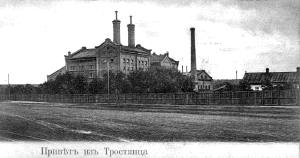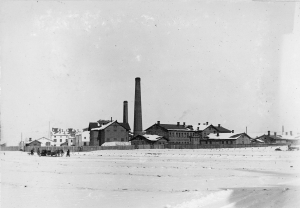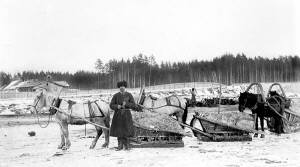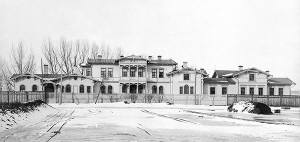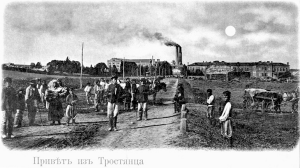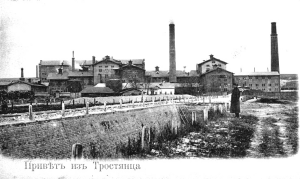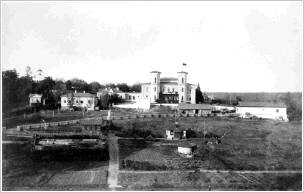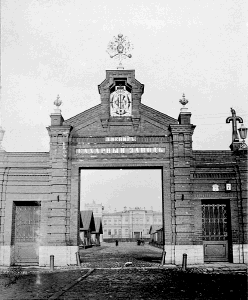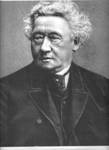

Georg Leopold Koenig (1821–1903)

Georg Leopold Koenig
Leopold Koenig Biography.
Click here - 14 pages, PDF.
With many photos.
On the 17th of December 1903, a remarkable man, Georg Leopold Koenig, died in St. Petersburg. The fifteen-year-old baker's son began to earn his daily bread by hard physical work as a sugar-refiner apprentice, and he ended his life as one of the greatest Russian industrialists of his time and as owner of refineries and extensive property, all of which was lost in the Russian revolution a few ye
ars later.
In
all of the huge changes in his exterior circumstances, however, inwardly he remained unchanged and true to himself. As an old and dying man, who at the end of his powerful life's work, when asked how he was feeling, he simply replied "schlecht und gerecht (bad, as it should be!)" In his innermost soul, he was the same person as the young man who, instead of complaining to his mother about his grueling work and his calloused hands, displayed them with pride and happiness.
Leopold was a German of the pure and powerful type. His father Johann Georg Koenig, a miller's son, came from the town of Gebesee by Erfurt. The young married couple, Johann and Elisabeth Koenig had their small business near the center of the city. The baker's sign, two golden lions with ring and crown on a blue background, hung on the street. The heat from the baking oven flowed through the two rooms where they lived, and from the small bakery room, the customers were engaged through a sheet metal sliding window from which they had to order outside on the street.
There, on the 13 th of November, 1821, their third child and their first son, Georg Leopold Koenig, known as Leopold, was born. His mother related later, happily and proudly, how early he had established his self sufficiency. As a small child, he crawled out of the wash basket, which at the time was used as a crib, without anyone knowing, in order to look around the apartment until he had seen it all. At six years old, he fell in love with a neighbor girl named Rosalie, and immediately announced determinedly to his father his intent to marry her. Of course, not everything worked out the way he had planned.
A greater indicator of his powerful entrepreneurial sense or spirit occurred when he, at thirteen years old, had been instructed by a baker about the properties of an umbrella, climbed to the roof of a barn and with an opened umbrella, with the solid expectation that he would fly, jumped to the courtyard below. Luckily, he only sustained minor injuries.
Slender, but muscular and sinewy, with bright eyes and brown curly hair, the boy was humorous, and, occasionally in an way that sometimes angered others. On dark winter evenings, he often would knock on the sliding door of German bakers, and when they responded with "What's that?" he would ask, mimicking the Russians, "Do you have bread?" When the answer came back "Yes", he would say "Thank God!" and leave quickly.
In both schools that he attended consecutively, the best that his parents could afford, he was loved by his teachers, since he learned easily and gladly. His classmates of the "better" citizens, at first, of course, watched the son of a baker with envy and sometimes were scornful. But, he soon consciously and energetically defended himself and upon a comment by one of his classmates such as "The baker boy with the bread is here," he yelled loudly from the door into the classroom "Not the baker boy, but the son of Mr. Koenig."
At home he received the strict upbringing of serious loving parents. There reigned reverence and respect - the respect of the man of the house, against whose word there was no contradiction. The respect for work, the coworkers in their white aprons, the "Mosjos", were the first concern of the woman of the house. Above all, however, was the reverence for the eternal, and more than just Sunday services, brotherhood and family prayers. The father set an example: by all the cheerfulness of his being, by all happiness with which he trafficked and even played with the children, he never entered a doorway without removing his hat and quietly praying to himself. The mother, however, depended with all of her soul and love on her son, who in all outward manners and gestures was like her. Would she fulfill her childhood dream through him?
In 1837, fifteen year old Leopold saved their lives and property. The family had already moved with their many children to a better home in Wassili Ostrow, the German section. There on the 17 th of April, the single story house in which they worked and lived caught fire. Leopold and his siblings were trapped inside, and since there was no apparent way out, he broke out a window with a chair and helped the others out. He even went back to rescue another sister.
At that time, at fifteen years old, he was ready to begin a profession. At first he wanted to become a builder and had already studied drawing at the Academy for Visual Arts. Then one day he suddenly declared that he wanted to become a sugar refiner. He had heard a voice at night that had told him to, the same voice that for the rest of his life would become his faithful advisor in every important decision. It became the voice of his inner strength and his innermost instincts, which came to him from deep in his subconscious, from his active imagination, or it spoke to him from an external, higher will to his sensitive ears.
On April 9 th 1837, Leopold became an apprentice to Karl August Papmehl, an old friend of his father's whom he had met in Posen, Preussia (now Poznan, Poland.) His father allowed him to leave the home with the admonition "Don't enter into your life each day without first praying Lord bless my work! Then you will succeed in everything." And Leopold attributes always his enormous success in life to the fact that he applied that advice to all of his activities.
Karl A. Papmehl, with whom he first began his apprenticeship, had traveled a good part of the way to St. Petersburg with Leopold's father, Johann Georg Koenig. They were fellow bakers from Poznan, and Karl later had taken a job in the sugar refinery in St. Petersburg on the advice of Johann Georg Koenig because he hadn't been successful in his bakery business there. Then later, he himself, owned a successful refinery in an at-the-time little developed part of the city. Of course the refinery wasn't big, and compared to the general standards of the time, it was primitive with regard to using manpower rather than machines. It was there that the slender apprentice, Leopold, along with the other workers, went to work at 1 am and worked continuously until 6 pm: In those 17 hours, there was only one single pause at noon, and the work was hard.
The refinery essentially consisted of a chemical-mechanical process to extract the brown sugar by first putting the sugar cane in boiling water to dissolve out the sugar, then filtering out the residue to obtain the pure sugar. In glowing heat and bad air, in cramped space, the filtered brown sugar was brought to a boil in open vats. The thick mass had to be constantly stirred using long stir sticks, which required no small amount of strength and endurance.
There, the slightly built young man soon had hands full of blisters and callouses and in winter when he came out of the refinery soaked with sweat, steam rose in the cold air from him and fell back on him as ice on his collar.
His mother quietly wept about the hard life Leopold was leading. His "better" school chums, who during this time had taken more comfortable jobs in stores and offices, shrugged their shoulders over the "slaving" that he had to endure. Leopold, however, remained unshaken in his choice of profession and was undaunted as he often gritted his teeth and said "sink or swim!" And, he remained enthusiastic, for in spite of the pain that he felt in his body, he felt the joy of his inner strength constantly growing. So, he gained spiritually by all of the hard work and suffering.
Of course, reading books, studying abstract fields or aesthetics was not his thing, but he enthusiastically, consciously, and instinctively followed everything that concerned his profession. He followed the sparse news from the sugar beet industry in the south of Russia that was barely visible at the time, but which would later develop into the greatest contribution to the industry. His mother had to cook sugar beets for him at home so he could get hands-on experience about every bit of news.
After five years, he was finished with his apprenticeship and ready for the first step of his chosen profession. Since Karl Papmehl at the time was dying, the wealthy and experienced man shocked the 20 year old, not yet of age and without financial means, by asking him to care for his children after his death.
In 1842, Leopold had saved enough money from his salary that he proudly was able to give his parents a silver goblet for their silver wedding anniversary. A few months before, suddenly his master Karl Papmehl, as he predicted, had died of a heart attack and Leopold had to find a new job because the refinery had been already contracted to be sold at his death. He then, a master himself, became a technical leader of an important large refinery in the outer southwestern part of the city. The owner, the rich industrialist Prokofij Iwanowitsch Ponomareff, an older man with a powerful white full beard, who dutzed (spoke informally to) all of his employees in a patriarchal manner, had at first hesitated to trust such a responsible position to one so young, but after a few years he was happy to give Leopold a raise at every opportunity.
In the meantime, from the slender and small boy, a medium-height, powerful young man had developed, who had taken advantage of every one of the few free hours that his work had left him to go in every direction. He sailed after work on the Neva out into the Finnish Sea. In fact, as his savings increased, he bought his own sailboat, dog, and his own horse. And as a dancer at the unpretentious balls of the German craftsmen and merchants, he was well respected, and with his uncomplicated joy, he enthused the entire company. Even at that, he, who had to be back at 1 am to work, promptly took his leave from the fun-loving circle at the strike of 10 pm.
And, his economic situation had improved so much that he could consider getting married. Even as an apprentice he had been fond of his master's eldest daughter Karoline Papmehl. Now he approached her in his decisive, direct way. He proposed and announced to the surprised seventeen-year old that if she could not decide immediately, then he was going to leave the following morning for England. She promptly said "yes!" That was in the spring of 1846 and in June their wedding was celebrated.
In 1848, at the age of 27 years, he was far enough along that he, who had inherited the entrepreneurial spirit of his mother, and the prudent, deliberate spirit of his father, made in good conscience the decision to go into business for himself. That meant he would acquire a refinery. Of course he couldn't yet afford it with his own resources.
On the Wyborgerseite, in the northeast of St. Petersburg among the wretched huts of the filthy suburb, stood a refinery for sale at a reasonable price. The husband of his mother's sister, a rich tailor, confidently made the necessary money available. His farsighted mother pushed him to take advantage of the opportunity. In fact, she even secretly contracted with the seller to pay him 2,000 Rubles more than he had asked for. So, the refinery was purchased, actually against the wishes of the buyers for 27,000 Rubles rather than 25,000. But, his first step on his own was not accompanied by good luck. In fact, it took all of his mother's convincing for him not to sell out after the initial shock of a sudden plunge in the price of sugar.
In St. Petersburg at the time, all in all, at the most, 10,833 tons of sugar were refined, and that production was distributed among 28 refineries, of which the largest produced at most 722 tons annually. In other words, the sugar industry was in a very early stage of development, because the market for the city's half million residents and a large part of North Russia obviously could use more sugar than was being delivered. In the industry itself, there was no great capital investment being made, which explains the annual production of its refineries only being 722 tons, about what could be produced today (1903) in one large refinery in two weeks.
All of the refineries were ugly, rectangular boxes with low ceilings and small window, farm huts in comparison to the refinery "palaces" of today. They were allowed, for there was no impetus to improve them. Also, the technical process left much to be desired. In short, the sugar refineries from a great number of larger and smaller capitalists operated more in the sense of the "good old days" than as profitable and efficient businesses.
Leopold Koenig's refinery on the Wyborgerseite belonged to the smaller of the mid-sized refineries with its annual production of some 433 tons. Koenig threw himself with all of his strength into the finding of the most efficient utilization of existing technology. Not for nothing was he the son of a painfully clean and parsimonious German craftsman. Not for nothing had he himself spent a dozen years in 15-hour work days over the boiling vats. Soon his reputation spread publically for producing especially good sugar. But also he was lucky commercially. With his smart, clean-shaven face, with his happy and quick look and his characteristic natural charm around his fine-lined lips, with his alert hearing, that while he listened to those near him, at the same time he picked up on the furthest away noise, he appeared by his nature to possess the qualities that the modern development of the industry required.
His established good reputation as an enterprising refinery leader, as well as his father's reputation as an honorable citizen through and through, allowed him to maintain an excellent credit line. That freed him from having to use his own capital to buy and sell and gave him considerable flexibility.
Within two years he had paid off all of his debts, and within three years he had already outgrown his refinery. He sold it advantageously and bought one that had twice the capacity in Ziegensumpfe in the Kolomna area of St. Petersburg where he had served his apprenticeship. At that time he thought back on prophetic words written on the stock market "Now he is bowing to everyone, but soon everyone will bow to him."
Shortly thereafter, the Crimean war broke out in 1853. England sought to cut off commerce with Russia and blockaded the import of sugar cane to Russia. As a result, the price of sugar soared to high levels. But, most of the well-supplied refineries held back their sales in the hope of even higher prices. Koenig, being more farsighted, sold all of his supply of sugar without regard to getting the maximum price, which nevertheless was a windfall profit. That decision paid off handsomely, for when the blockade was dropped suddenly and unexpectedly, the price of sugar plunged. Koenig was freshly empowered and enriched, while most of his competitors suffered heavy losses, and a large number of them had to close their refineries.
In the meantime, in Germany, a new process of boiling the sugar cane in vacuum-sealed containers that were heated by steam was being introduced to replace the cooking in open vats heated underneath by open fires. That meant a high reduction in the required manual labor and heating energy, the capability of getting a higher percentage of the sugar out of the cane, and a greater purity of the sugar. In addition, it made possible an incomparably faster processing and a correspondingly greater productivity than in an otherwise similar refinery.
In a word, here was the decisive step from hand work in the refinery to a modern industry. Also, other men with a keen sense of business in St. Petersburg understood that too. The first to act was a representative of the firm Molvo, who in the year 1855 had his refinery outfitted with steam. Koenig, however, first personally traveled to Germany, not only to see the equipment with his own eyes, but also to learn the entire process by doing it himself in the Elbseiderei in Hamburg. Koenig, the refinery owner who now worked as a boiler master, undertook every small job with such enthusiasm that his coworkers had no idea that he would be departing in a few months to return to being a Russian refinery owner. Thereby, he learned and mastered the entire process in small detail that he would later introduce, in contrast to the majority of those who hired, for better or worse, foreign experts to run their businesses.
So, in 1855, Koenig bought a larger refinery in Katharinenhof, immediately near the powerful Waldpark Peter the Great, and began to completely rebuild it and equip it with steam power. His ambitious mother supported him in all of these ventures. She helped him with the move from refinery to refinery, she oversaw his construction, and she took care of legal and business matters. His father, likewise, watched Leopold's progress with pride.
Then, on February 1, 1856, Leopold's 71 year old father, in complete surprise and to the shock of his family, suffered a heart attack. Half crippled, he lived another 14 days completely conscious and taught his children a proper death in which he prepared longingly for death as if it were a holy completion of his life.
At the time, however, Leopold was especially consumed by his work. He oversaw his new construction to completion. A year after his father's death, he gave up the Papmehl refinery in Ziegensumpfe and opened simultaneously the new steam-powered one in Katharinenhof. There he refined within a short time almost ten times more than he could before. But, he introduced still another highly important upgrade to the steam process.
At the end of the 18 th century, Achard, a student of the Berlin Chemist Markgraf, in his professor's research, had discovered that one could get crystalized sugar out of beets, and with the help of the Prussian State, had been developing the method in a big way in Germany. The process was also known in Russia, but the industry developed very slowly in Russia because of a lack of commerce routes with the south, which had the black dirt that was well suited to growing the beets.
Only in about 1874, after the railroad system of the Russian Reiches was constructed, were sugar beets delivered to refineries in large enough amounts to be sufficient for the total production in Northern Russia. That provided the opportunity for the refinery owners to personally examine the production capabilities of the suppliers and of the managers who had to include the harvest predictions of the beets in their business calculations. So, at that time the sugar beet business spread and diversified in one strike in which lively exchange relationships were established.
Again, Koenig was one of the first northern Russian industrialist to recognize and utilize the advantages that they offered. Already, fifteen years earlier in 1859, while the entire sugar beet production of all Russia climbed to 72,000 tons, he alone produced 4,500 tons from beets in his refinery.
And now he arose more and more clearly into a commanding position. Already, he produced half of the total production of St. Petersburg. The old fire refineries fought a hopeless battle for survival and finally closed. However, also the new steam-driven refineries had to work hard to compete with the increasing power of a new refinery. On the Wyborgerseite, separated by only one street from the primitive little refinery in which Koenig began his own business, a powerful new refinery had risen on the bands of the Neva. The building style had been modeled after an early Swedish church, with a large garden and a wide courtyard. Its owner set himself in competition with Koenig, but eventually lost and had to sell it to him. Thus, Koenig increased his production up to 18,000 tons, about 50% more than all the 28 refineries in Petersburg had produced a few years before, he now produced in two refineries.
Then, in 1864, the Molvo company gave up business after it was damaged in a fire. The Papmehl refinery was converted into a distillery and nothing more was heard from Ponomareff. Leopold Koenig was the sole master of refining for as far as the Petersburg market reached. But the master was no tyrant. He was too farsighted and too careful to raise prices in a disrespectful manner, and to cause a revolution against him. Also, the egotism that usually goes with exploitation was foreign to his good nature. For, it was not just a vacuous phrase, but it was his deepest life's conviction that he expressed to ones he knew "To me, it's not as if all of this that I have acquired belongs to me. To me, it's as if it has been given to me to take care of."
To his sons, he occasionally said "God has blessed me with wealth, but he can take it from me at any time. Search to learn, for that alone stays. Everything else is temporary." There he was without the slightest ego, master over life with its suffering and troubles. With happy singing and whistling, the "Sugar King" arose at the crack of dawn and in the evening he shed his troubles along with his clothing.
Thereby, it fulfilled him in his characteristic way with a special pride, that, as he expressed it, he was entrusted to provide so many a living (their daily bread.) And he took care of them in the manner of a head of household, benevolent and smart.
With the higher-level employees, he shared a certain percentage of the profits of the business. Also, in contrast to the at-the-time normal indifference towards the workers, he tended to their working conditions and their health. Thereby, it became a great preference to work for Koenig and the best workers swarmed to him. Of course, he was demanding of their performance, but without unnecessary rudeness. He had a disdain for everything crude and was against everything rough handed in his so tender nature.
Never again had he laid a hand on anyone since in his rash youth, he pushed an impudent down a flight of steps. True, he avoided it by scolding in a raised voice. But as he himself served as "administrator" both in respect and passion, so he also demanded respect and passion, and for the lazy and undisciplined, there was no place.
In his personal evolution, however, in spite of all his luck, he remained accessible, humble, and amiable. When he moved into the Katherinenhofer House on the Waldpark, with the stately rooms and the old massive furniture, he maintained still a humble simple lifestyle. Also, he reduced his social life when his wife became sick and because of his own reluctance for all publicity about his family circle. His sons, he raised with as much care as it was possible with his nature.
In the summers, he traveled usually alone or with his family to foreign countries. He traveled to Paris and London on business and for pleasure. German spas, the Riviera with Cannes, Nizza, and Menton, were common goals. Thuringen with his recollections of Luther (Martin Luther studied at the university in Erfurt, about 12 miles from his father's hometown of Gebesee) and of his own ancestors. The Harz, Switzerland were visited, and frequently the man sat in his favorite places of his happy childhood in order to take in folk art and to experience local culture.
During these trips, he had, of course, many adventures. So it happened in spring of 1861, when the steamship in which he traveled from St. Petersburg to Stettin (in 2007, Szczecin, Poland) ran into a hurricane and almost sank. He groped his way to a seasick passenger in the cabin and said "get up, we're going under!" For he liked so little to talk about it, and he feared dying even less. So often he faced death, that he, only at the bidding of a higher order, at the last moment appeared to have tried to prevent it. As a young apprentice who bent over the glowing hot vat of sugar pulp, he once lost his balance and only at the last moment was yanked back by a coworker. As a master, however, he could climb through several stories of an open elevator shaft on foot while holding a burning lamp in his hand, without injuring himself.
Koenig had eliminated every one of his competitors, but after a few years of running his refineries, towards the end of the 1860s gradually the "sugar relationship" entered a change in the St. Petersburg market. The expansion of the railroad system made it possible for competitors from the west and south (Ukraine) to enter from the large refineries. Koenig realized that his monopoly would not last. Quickly he decided in 1867, now 46 years old, to close his Katharinenhof refinery. Simultaneously, he decided for the health of his family to move to a milder climate. He moved with his family to Bonn, Germany. On the banks of the Rhein across the river from the legendary Seven Hills, he acquired a mansion on a gentle slope with extensive gardens.
He was comfortable in the serene fruit and wine rich regions, in the industrial areas, and in the University community of Bonn. He established a friendship with several professors, and he attended colloquia on applied science such as chemistry. He also attended colloquia presented by professor von Siebel on history.
In multiple modifications, he expanded his house to the status of a stately villa, but nevertheless, he maintained an air of simplicity and natural freshness that was typical of his nature. He maintained horses, cows, hounds and other animals as though he were in the country. He added a playhouse and small cannons, which his guests applauded when they were fired to greet the steamers that moved up and down the Rhein in the evenings. Often he received visits from relatives and good acquaintances. Proudly he showed them the area and happily drank good wine with the men. His favorite saying was "work when I work, and be again happy with me," a verse which he wrote on his portrait for friends and family members, he designated himself as the kind of man who loved both work and good company.
There in Bonn, he celebrated his silver wedding anniversary in the year 1871, shortly before his 50 th birthday and just after he had experienced the German-French war in the vicinity. His now 74 year old mother visited him for the celebration, but the wise and active old woman was only half-hearted in his beautiful villa. And she was also half-hearted about the purchase of the stately nobleman's estate Gut Boekel in Westfalen, which he acquired three years later for his eldest son Karl. They were only play things for her son and she wanted him to do greater things. In actuality, he also wanted to do new and greater things. As a refiner and businessman, he had attained a high level of technical expertise and competence, which was satisfactory to him, but the creative genius of the man was at work to push him to expand his operation to produce the sugar beets for his refinery.
In southern Russia, Ukraine, where the soil (which was called 'black dirt') was very rich and fertile, the sugar business was already being developed. Areas of black dirt produced the beets in abundance and everywhere high factory chimneys were rising across the flat lands between the quaint hills above the straw-covered mud huts, the church steeples, and cherry trees of the villages. Here the complete business was developing, that is, both the sugar beets were grown and processed there.
In the fall of 1874, Koenig acquired, in the province of Kharkov, the Manor Trostianetz, with a distillery and a sugar refinery that produced over 1,805 tons of sugar annually.
The manor Trostianetz, with it's land, in total spanned an area of over 50 square miles (32,000 acres.) This huge property, which a few years earlier had been the property of Prince Galitzen, was on a railroad line between Kharkov and Kiev on the edge of the hilly land near the great south Russian plains, which had been for centuries the battle ground for Tartars, Turks, and Kosaks.
To Trostianetz, his central focus, Koenig soon began systematically adding new acquisitions of land with soil that would supply beets to his factories from his own property. Trostianetz was, in spite of the at-the-time in Russia so badly mismanaged forest and fields, still doing relatively well since they were trying to avoid the breaking up into small farms. He acquired the complex of Krasnkoje, which was for a long time a place of beauty, contained a proud forest of several varieties of trees, of 22 square miles (14,080 acres) in a single piece, with oak and ash trees up to 400 years old. And as for agriculture, at least at the time a few ambitious "forces" applied, when they weren't hampered by a lack of a farsighted management and a lack of farming resources.
Koenig's strong point was a solid will, which included a plan and order, in which he organized them by using the latest technologies. And immediately he put his entire effort into the activity. He gave all areas of expertise the 'Koenig Spirit' of high quality craftsmen and high expectations and strict supervision: As he drove his land, his animals, and those who cared for them even harder, so he also stood by his word, that what they delivered to him would be compensated by generous pay, housing, and expenses, by good stables, feed, and fertilizer, things for which his kind were widely known and praised by most industrialists and land owners, and which won him the love and trust of his employees in spite of all his demands.
Then he imported with a clear comprehension of the essentials, modern forest management. The existing good but unkempt and wild stands of forest came into management. Above all, however, he began to renew the failing and cut-down forests. All this evoked wide criticism and ridicule, for in Russia, the forest was, in general, considered to be a natural creation and best left to the care of nature and it appeared to them to be the height of absurdity and conceit to "plant" a forest. But Koenig did not yield to either mockery or threat. He continued steadily, unconcerned through all ups and downs, to go the way his "inner voice" told him to go.
For these acquisitions of her son, his old mother had full knowledge, but she couldn't rejoice in it any longer. In May 1877, shortly after she had celebrated her 80 th birthday, she lay on her death bed. Her son, who received a telegram from Bonn, came immediately in order to spend the last moments of her life with her. From the moment in which he arrived to his already unconscious mother and laid his hand softly on her forehead, was her loudest death rattle in her throat, then she took her last breath.
He himself was now close to 60 years old, but he still whistled his morning song as he arose in the morning, and healthy to his last fiber, fresh as though right out of the bath, went the thick-set, cleanshaven man with the bright and enthusiastic face and the grey locks of hair.
In 1881, he took on a new project. In Guty, on a sugarbeet farm some 60 kilometers east of Trostianetz on the new railroad line, a refinery had burned to the ground. He acquired the 15 square miles of land under favorable conditions and immediately rebuilt the refinery in the same style as his refinery in Trostianetz. Here in Guty the typical mismanagement of land and forest had completely dominated. However, that didn't bother Koenig. With the same resolve and resources as in Trostianetz, he undertook a fundamental reorganization of the farm. He created in Guty a second center of his land acquisitions. Besides that, he established here the beginning of a new work culture of great style. Numerous swamps decayed in the low bottom land areas of the rivers and creeks in South Russia and poisoned the air with noxious gasses and mosquitos during the summers, so that the entire population of some villages was chronically sickened with malaria.
Koenig began with the recognition that here a new pastureland was to be gained by draining the swamps between the villages and the Guty refinery via canalization. While he worked still in full health, an insidious decline in the sugar business began in St. Petersburg, which was under the management of his best coworkers and employees. So, Koenig moved out of Bonn again back to St. Petersburg and made his home at Wassili Ostrow, next to his office in the great residence that he built there where his father's bakery had once stood in flame. It was there, at the site of the refinery that had experienced continuous growth, that he engaged in a difficult "sugar battle!"
And, with the powerful growth of the railroad system in Russia, the sugar beet and refinery production astonishingly had increased. In 1900, 1.14 million tons of sugar were produced whereas there were only 0.22 million tons produced in 1874. With that, the sugar consumption couldn't keep pace although it nevertheless rose. The resulting sinking of the sugar price, however, caused the sugar industrialists to seek means to counter it. Then in 1885, their resistance to the crisis was finally broken. The price plunged, and also Koenig, as the last of the power structure, had to join them. It was the decisive turning point in the production of sugar production from the era of 'irrational exhuberance!' to where the industry gradually had to back off into calmer mode of business.
However, that didn't dampen the entrepreneurial spirit of a so-important capitalist as Koenig. In spite of the bad times, he enlarged his refinery on the Wyborgerseite in the next few years, and in 1888, he realized his dream plan from long ago. He built in South Russian, in Trostianetz, where he grew the beets, next to the brown-sugar factory, at the cost of around two million Rubles, a new refinery of great style.
With this refinery, however, he had completed his own world. He had put the finishing touches on his farms to combine them into independent, individual undertakings of agricultural-industrial units. In their realm, the 'sugar experience' had played itself out, from its planting beets to its finish in the refinery. There, he moved his center of operations from Petersburg finally to the south, and more and more often he appeared at his farms for increasingly longer stays.
His private life progressed to where he enjoyed more and more the serenity of being surrounded by his family. Already in 1886, he had moved from Wassili Ostrow into the master mansion on the refinery courtyard in order to be closer to the refinery. There, the active man who had enjoyed his childhood, enjoyed the large family gathering at Christmas time with his grandchildren, nephews and nieces. In the great family room, he assembled them in front of the dark tree, and when he read the happy message from the Evangelical, he emphasized the words "The clarity of the Lord lights your way" and then pushed the electric light switch that suddenly made the dark fir tree come to life with light.
There appeared his first sign of aging, a gall stone, which in 1889 sent the otherwise solidly healthy man to an operation in St. Petersburg and forced him afterwards to visit the spas at Kissingen and Bad Wildungen several times.
The diminishing of his circle of siblings made him more sensitive to his mortality, the most painful of all old-age suffering. The circle diminished ever more, and in the fall of 1894, after suffering a long illness of heart disease, his wife also died. But, he trudged on and on with every inner faith that earthly life was only a temporary wave in the eternal life. Also, the graves of those over whom he wept, gave him the creative power again and again to continue his work.
By now he had brought his refineries and his farms to the highest pinnacle of their development. To Guty and Trostianetz he had added over 20 new farms in the course of the years. That meant that the total land ownership of Koenig amounted to an area of 125 square miles with a perimeter of 45 miles. Of that, every square inch of land was put into productive use, and over 7.3 square miles of poisonous swampland had been converted into flourishing agricultural land. Overall, where earlier barren land or quicksand lay, where the sloping hills met the mud, where water runoff eroded the fertile soil, one now sees reforestation in various stages. And soon, the growing forest began absorbing the rain as well as protecting the soil from drying out in the dry season.
So, Koenig had created a powerful region of fresh productive culture in the heart of Southern Russia. And, as a result, his staff of employees who worked this enormous business, grew. In the fall season, when refineries and agriculture together were at their peak activity, it grew to an army of over 20,000. However, also in winter the work did not stop. All over, Koenig kept his army of poor farmhands in the region busy on the farms and in his refineries, and they reciprocated with ever more loyalty and skill.
And, still more. At first the small Russian farmers had been mistrustful and critical of the new kind of agriculture. But, when the fruits of the quality works turned into rich harvests lasting for days, they began with time to accept and apply it themselves. By using deeper ploughing and more careful harrowing, his small plot of land produced better. Also, Koenig had built clean and carefully run hospitals, which he opened to the entire area. At first they were not used because of superstitious mistrust of the "master's healing methods." But, gradually, they overcame their mistrust and began to use them and to develop first-class hygiene. The schools also became in more general use, and of them, Koenig himself founded a big education center in Guty.
And again and again, unconcerned that at his age he could attain nothing more for himself from the fruits of his wealth, he continued to disseminate it wherever there was promise that new life could sprout.
So, the baker's son had climbed to the highest pinnacle of his enterprise, which in restless creativity, in the happy demands of life, had found its prosperity. He had been an acquiring and successful industrialist and businessman, a man of unsatiable striving, but was, as an old man, so unaware of his own modesty.
He had finished his life's work, but he was now slowly beginning to fade. His eldest surviving sister now lived with him at the Wyborgerseite, since he lost his wife. An unmarried niece took care of him and traveled with him. It was a task that became more demanding on every front, as with the years, his memory gradually failed, and as he himself painfully began to realize, his ability to understand his gigantic empire began to cloud.
From his 80 th birthday on, which he celebrated November 13, 1901 in the most intimate circle of family, his strength failed visibly faster. He became more and more sensitive to every disturbance and he preferred to sit at home in the company of his last surviving sister, silently on the sofa, sunken down in it.
His distant childhood and youth he saw with the wisdom of age, clear to the finest detail, but the recent past, the today and yesterday he found only in the fog. His powerful body withered away until he was skin and bones, and his face seldom showed recognition, and more and more it looked like the face of his mother, as if she appeared in him as she had always lived in him.
On December 8, 1903 in the morning, his niece observed that as he walked passed the picture of his deceased wife, he joyfully spoke "soon we'll see each other again." On the same day, he lay down. An old blister wound had begun to fester. Then began a fever to gradually sap his strength. In the failing body, however, awoke the clear eyes of his soul.
Now fully conscious, he lay nine days on his deathbed, and also his memory had returned, so that he again recognized everyone who he for years had mixed up with figures from his childhood. Without the slightest hesitation, he looked forward to his death in his miserably weak condition. He retained his religious nature to his last breath. He refused any comforts, as someone wanted to bring him a water mattress "I'm not a clown that you can put on a water mattress. That's too much of a water underground for me!"
When he was so weak that the slightest disturbance sapped his energy, he dictated how his guests should be brought to see him. In the middle of the deepest sadness, as the large group of grandchildren came to see him for the last time, he joked with them and said "There comes the funeral procession already!"
With the Pastor, however, who was of the same solid and straight type as he, he toasted his death with a glass of fine wine. And as the last of his family had assembled before him, he asked them to his bedside and spoke his blessing with a wavering hesitating voice. On the evening of December 16, he lost consciousness, but he lived until finally at 4 am the next day when he stopped breathing.
Of the many who attended his funeral, as he lay in state, one sobbed in the deepest sadness. He had been a worker for Koenig for almost 60 years, who had moved from refinery to refinery to work for him.
On the 20
th
of December, funeral services were held for Leopold Koenig by the Katharinenkirche in Wassili Ostrow. His refinery employees, who comprised the church choir, filled it to the last seat and later joined the two-hour long funeral procession to the cemetery at Wolkowo. It was the wish of Koenig that no official ceremony was held. Only the pastor spoke, who had been with him his last few days, and an old friend made a short speech afterward.
* Dennis D. Weber. From Russia to Roseburg. Stories of Webers and Koenigs who immigrated to Russia, merged, then after almost a century, immigrated to Roseburg, Oregon in the 1890s.
Published in January 2007 by www.Lulu.com .
Order this book at http://www.lulu.com/product/paperback/from-russia-to-roseburg/653579 .
Georg Koenig's
St. Peterburg sugar refinery
Leopold Koenig: Sugar King
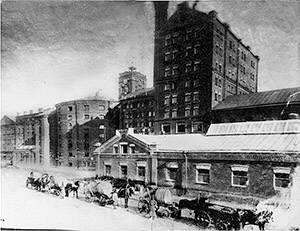
Koenig's Sugar Refinery at the Wyborgerseite in St. Peterburg

Leopold Koenig's home near the above refinery in St. Peterburg.
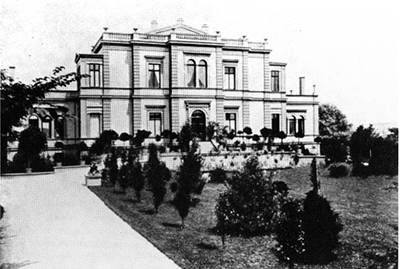
Leopold Koenig's Villa in Bonn, Germany.
Now (2007) known as Villa Hammerschmidt, the home of the president of Germany.
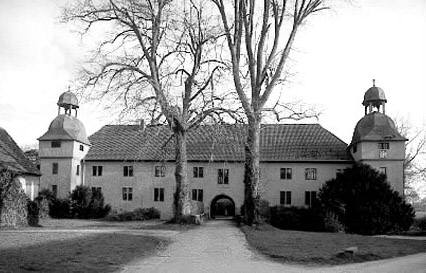
Gut Bökel, the home Leopold bought for his son Karl.
It later became the home of his granddaughter, Hertha Koeing, a well-known author and poet.
Today, Gut Bökel is a German State Park.
It is a Wasserschoss, that is, a castle surrounded by a moat.
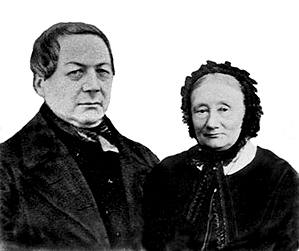
Johann Georg and Elisabeth Koenig, parents of Leopold Koenig
